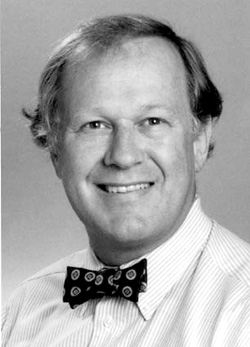
Dr. MacRae Linton

Dr. Sergio Fazio

Dr. John H. Newman
Three Vanderbilt physicians were recently honored with the Elliott Newman Prize from the Department of Medicine.
Dr. MacRae F. Linton, associate professor of Medicine and Pharmacology, and Dr. Sergio Fazio, associate professor of Medicine and Pathology, were presented the Elliott Newman Prize for Basic Research. Dr. John H. Newman, Elsa S. Hanigan Professor of Medicine, was awarded the prize for clinical research.
The prizes, named in honor of Dr. Elliott V. Newman, Vanderbilt’s late distinguished clinician-investigator and founder of the Vanderbilt General Clinical Research Center, are awarded annually to two groups of faculty and his/her research team for excellence in basic or clinical science research.
“These findings represent some of the finest work done by anyone in medical research last year,” said Dr. Eric G. Neilson, Hugh Morgan Professor and Chairman of the Department of Medicine. “We are proud to have Vanderbilt recognized along with their contribution to science.”
Linton and Fazio identified a lipoprotein’s key role in the formation of atherosclerosis, the leading cause of death in the United States, and helped establish a link between heart disease and diabetes. Their findings, published in Nature Medicine, could lead to targeted therapies to prevent both diseases.
The protein, aP2, had previously been linked in mice to insulin resistance and hypertriglyerceridemia, two risk factors for heart disease in a cluster of symptoms—others include high blood pressure, abdominal obesity and premature atherosclerosis— known as the metabolic syndrome. aP2 or adipocyte fatty acid binding protein is known to be expressed by fat cells and macrophages. Since macrophages play a key role in atherosclerosis by accumulated cholesterol in the artery wall, the investigators wanted to see if aP2 influenced plaque buildup in arteries.
To test aP2’s role in atherosclerosis, Linton and his colleagues used mice genetically engineered to be at risk for the disorder. Through bone marrow transplants, they disabled the mice’s macrophages from producing aP2.
When the mice were fed a regular diet, one that would not change insulin resistance or plasma lipids, they were highly protected against atherosclerosis in the absence of significant changes in lipid metabolism or insulin sensitivity. These results show that in macrophages, the protein promotes the formation of foam cells, cholesterol-loaded macrophages present in the initial events of atherosclerosis. That role, Linton said, is independent of its effects on insulin resistance or increasing plasma lipids.
Moreover, the study showed that mice lacking aP2 have macrophages that are less likely to accumulate cholesterol and that secrete fewer inflammatory cytokines, Linton said.
The study also is the first to link aP2 to both atherosclerosis and insulin resistance insulin-resistance diabetes, Linton said.
Newman and his team discovered a mutation that not only explains the hereditary form of primary pulmonary hypertension, but also a significant number of apparently non-familial cases where there is just one person in the family with disease.
“The hope is that if we can understand how the mutation causes disease, we can start designing therapy to prevent it,” Newman said.
In a study conducted over a 20-year period, the researchers developed a registry of 67 families affected with familial primary pulmonary hypertension (PPH) or high blood pressure in the lungs, a condition that is caused by scarred and obstructed arteries in the lungs.
The group linked five separately identified subfamilies that included 394 known members spanning seven generations. The cases were traced back to a Grundy County couple in the 1830s.
The study was published in the New England Journal of Medicine.













